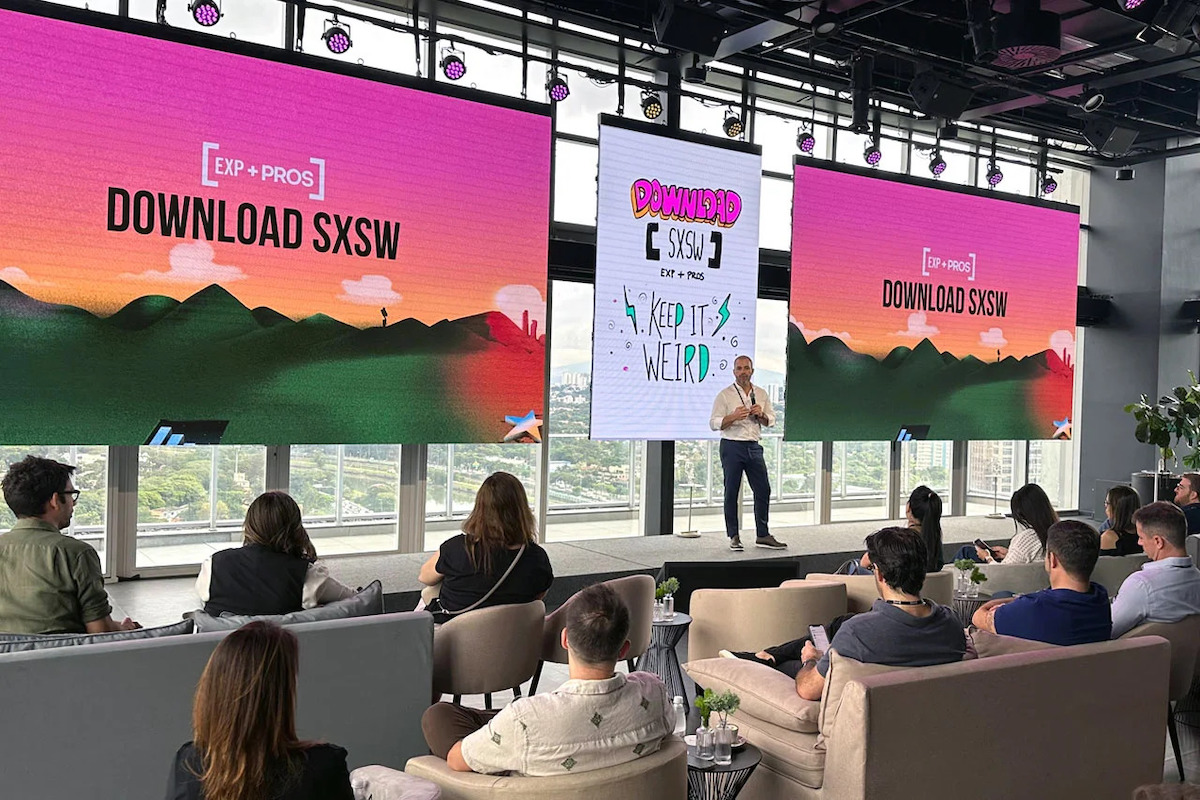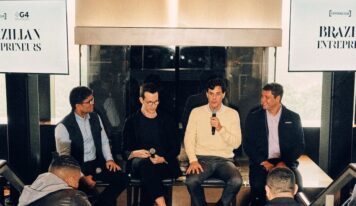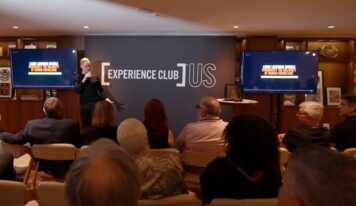Social health, biotechnology, quantum computing, the future of work and longevity were the main highlights of this year’s event.
An event that brought together more than 300,000 people over nine days in Austin, Texas – 50,000 of whom closely followed the more than 1,727 talks and content panels. South by Southwest 2025 also featured 1,673 shows, 215 brand activations, 508 movie screenings and 31 immersive virtual and augmented reality experiences (XR Experiences).
With such huge numbers, summarizing this immersive experience in a single piece of material seemed almost impossible. But the [EXP+PROS] mission took up the challenge and dove in headfirst to bring together the festival’s most emblematic, provocative and transformative themes in Download SXSW. Check out the result below and get ready to rethink the future.
THE PROVOCATIONS OF THE MAIN KEYNOTE SPEAKERS
1) Amy Webb, CEO and Founder of the Future Today Institute
A regular at SXSW, Amy Webb believes that we are entering “Beyond”, an era in which we are experiencing the impacts of the integration of artificial intelligence, sensors/wearables and biotechnology, which she calls living intelligence. This scenario marks a transition point where the social and physical rules we know today will change completely.
Amy presented some examples of this living intelligence in action:
– Multi-agent systems: Altera put a thousand autonomous agents into Minecraft. Without human intervention, they organized themselves as a society, created their own currency and made decisions autonomously.
– DroidSpeak: For AI, the human language is a limiting factor, so they communicate with each other in a mathematical language, which guarantees more speed, less energy consumption and more effectiveness.
– Embodied AI: AI needs to be physical to work better. By giving the technology a body, it can interact with the physical space to perceive nuances, reactions and emotions. An example of this is Blackrock Neurotech, which has developed a technology that controls devices with thought alone, using neural signals captured directly from the brain.
– Bioengineering: Bricks that work like human lungs, purifying the air in the house; rice that produces cow’s milk and even a computer built with a mixture of silicon and real neurons (from Cortical Labs). These are all technologies that blend the biological and the digital, breaking down the boundary between man and machine.
2) Niall Firth, executive editor of MIT Technology Review
As every year, the reporters and editors of the MIT Technology Review put together a list of the main innovative technologies that will change the world. One of the highlights of the presentation by Niall Firth, the publication’s executive editor, shows how AI is transforming the way we search for information. It brings together summarized answers from multiple sources, which bring challenges related to the accuracy and reliability of information. Studies show that ChatGPT, Perplexity and Gemini often present incorrect or misleading information, with up to a 60% error rate (tests carried out by the Columbia Journalism Review).
3) Charina Chou, COO of Google Quantum AI
The potential of quantum computing to solve complex problems such as curing various incurable types of cancer is what attracted Charina Chou to work with the technology. “Quantum computers are capable of solving problems that are impossible for AI or supercomputers,” she emphasized.
The COO of Google Quantum AI also said that the current stage of quantum computing is still far from what it can deliver, but it is already much faster than classical computing can do. Willow, Google’s quantum chip, for example, solved in just five minutes what would take 10 septillion years in classical computing, done by supercomputers.
The essential thing, according to her, is to ask ourselves what complex problems we want to solve with the creative potential of quantum computing.
4) Ben Lamm, CEO of Colossal Biosciences
It was at SXSW that Ben Lamm first announced that he would bring a mammoth back to life with research from Colossal Biosciences. A few years later and with investments that have already reached US$ 435 million, he will return to the SXSW stage in 2025 as Keynote Speaker to present the Woolly Mouse, a “mammoth mouse” with fur genetically similar to that of mammoths, which can withstand low temperatures.
If Ben’s research is still far from fulfilling its promise, his speech on the power of biotechnology to correct the mistakes of the past and guarantee humanity’s future captured the audience. He argues that we will lose 50% of the planet’s biodiversity by 2050 and genetic technologies can save us from this bleak future. His proposal is to create a biological bank of animal life, along the lines of the seed bank in Scandinavia, in a sort of “Modern Noah’s Ark”.
5) Meredith Whittaker, CEO of Signal, and Jay Graber, CEO of Bluesky
While biotechnology points the way to regenerating the planet, another discussion was highlighted by keynote speakers Meredith Whittaker (Signal) and Jay Graber (Bluesky). Both advocated a more open and decentralized future and harshly criticized big tech’s control over technology.
“The only way to protect data is not to collect it,” said Whittaker, emphasizing that Signal was designed with this premise. For her part, Hay was emphatic in declaring that Bluesky puts the user’s interest at the center of the platform and not the profit generated by advertisers.

OTHER NOTABLE TOPICS AND SPEAKERS:
The power is in the weird
Douglas Rushkoff, author of more than 20 books, such as Human Team and The Billionaire Mind and one of the greatest thinkers of the modern era, believes that in order to realign the course of technology, it will be necessary to invoke the “weirdness” of Austin, which has made the city a creative hub. Rushkoff believes that tech entrepreneurs want to maintain the established order and disrupt some verticals, but not the core of the problem, colonial capitalism. “Nothing in nature grows exponentially forever, except cancer and it kills its host,” I compare, criticizing the infinite growth model that shapes big tech.
Rushkoff argues that it’s time to return to intuition, empathy, mutual aid, sexuality, spirituality and even the ritual use of psychedelics. “We need to make the internet weird again,” he said.
Cowardice that leads to fascism
In the same critical vein, NYU marketing professor Scott Galloway spoke about what he called the “dominoes of cowardice”. He pointed to CEOs in the technology sector as accomplices, albeit by omission, in a process of erosion of democracy in the United States.
For Galloway, blind submission to the interests of shareholders is leading us down a slow but real path towards fascism. “We are entering an era of brutal consolidation. The market will reward predators,” he warned.
For a more collaborative technology
Tim Berners-Lee, the creator of the World Wide Web, provided an essential historical counterpoint. He recalled that the web was born collaborative, built in community, with the aim of benefiting the user – not generating profits for technology companies.
In the current scenario, innovation is following the opposite path, with big tech acting in an isolated and competitive way. “Who does AI work for? Will I have a robot that actually works for me?” he asked provocatively. He advocated a more humanistic view of technology and criticized the isolation of big tech companies, which used to collaborate and now act like closed islands, prioritizing only their own profits.
Generalists take precedence over specialists
This need for a new mentality also permeated the speech by Mike Bechtel, futurist at Deloitte. For him, in the future, the winner will not be the one who knows the most, but the one who can adapt best. “Let’s be intellectually promiscuous,” he encouraged, pointing out that while machines are superior in memory and processing speed, humans still have the advantage of connecting diverse knowledge in a creative way.
He used the polymath suit to highlight the profile of the future, i.e. someone who knows multiple sciences and is prepared for the unexpected challenges of the real world. According to him, the most valued professional profile will be one that combines critical thinking, a repertoire in the arts and humanities, logic and the ability to improvise.
Complementing this vision, Ian Beacraft, CEO of Signal and Cipher, stressed that the future will be of creative generalists: curious, adaptable and willing to learn, unlearn and relearn in ever shorter cycles. “We need to move away from the ‘I am what I know’ mentality to ‘I am how I adapt’,” he said.
He also presented an impactful timeline on the durability of professional skills. While in the 20th century they lasted 30 years, today they barely last two and a half years, and could be as little as six months. To keep up with this speed, the new education will need to be much more dynamic, based on micro-credentials, real-time training and immediate practice.
Rethinking work
Rishad Tobaccowala, futurist and author of the book Rethinking Work, argued that in order to be successful in a world that is constantly changing, you need to take a fresh look and not stick to ready-made formulas, but always think ahead. He believes that work needs to be seen as a playlist of tasks in constant movement and that leadership will no longer be about control, but about cultivating people and talents. In short, the work of the future will require autonomy, real purpose and a rediscovery of the centrality of the human being.
This new way of looking at work can already be seen in the choices made by Generation Z, which values freedom, distrusts rigid hierarchical structures and prioritizes experiences over stability. That’s why 66% of those who have jobs maintain parallel activities. Digital by nature, they prefer not to meet their bosses in person. They want flexibility, agility and environments that respect their individuality.
At an event dictated by technological trends, the most powerful conclusion was that the future increasingly demands a return to human connections.
Longevity: ready to live up to 150 years?
The integration of artificial intelligence, biotechnology and new cell therapies is transforming the way we age and is already projecting a life expectancy of up to 150 years. But longevity isn’t just about living longer, it’s about living better. Studies indicate that 90% of the factors that determine longevity are related to lifestyle and the environment, while genetics contributes less than 10%.
Dr. Peter Attia reinforced this logic with the concept of Medicine 3.0, which focuses on prevention, anticipation and action before the body goes into decline. He warned of the phenomenon of the “marginal decade”, the last ten years of life which are often lived in physical and cognitive suffering. And if there is a “longevity pill”, it goes by the name of physical exercise.
Centenary Decathlon (by Dr. Peter Attia)
Functional skills for autonomy and quality of life until the age of 100:
- Walking 2.4 km on a trail with ups and downs
- Getting up from the floor using no more than one arm for support
- Picking up a 13.6 kg child from the floor
- Carrying two 2.3 kg shopping bags for five blocks
- Place a 9 kg suitcase in the overhead compartment of an airplane
- Keeping your balance on one leg for 30 seconds with your eyes open
- Have sexual intercourse
- Climb four flights of stairs in up to three minutes
- Open a jar with a screw-top lid
- Do 30 consecutive rope jumps
David Sinclair, professor of genetics at Harvard Medical School, believes that living to 100 with the vitality of a 50-year-old is closer to reality than we think. Epigenetics, which studies how external factors affect the expression of our genes, has been showing ways to reverse cellular ageing. According to the Information Theory of Ageing, we age through the loss of epigenetic information, like a scratched CD. Therapies can restore the function of genes or reprogram the signals that activate or deactivate them.
And the promises are already beginning to materialize. The MIT Technology Review highlighted real advances in the use of stem cells to treat diseases such as type 1 diabetes and epilepsy. In tests, these therapies regenerated insulin-producing cells and significantly reduced seizures, opening doors to a future where curing what was once chronic will become part of the medical routine.
Social Health: the mental health of the next decade
The opening theme of SXSW 2025 was chosen as the closing theme for this Download. Kasley Killam, an expert in social health and author of the book The Art and Science of Connection, argued that the concept will be the focus of mental health in the next 10 years. Social health refers to an individual’s ability to develop healthy and functional interpersonal relationships that contribute positively to their overall well-being.
Killam brought up data that proves the importance of the topic in current affairs: 24% of people in the world feel lonely; 20% have no one to ask for help; loneliness can be as harmful as smoking 15 cigarettes a day; the absence of connections increases the risk of cardiovascular disease by 53% and the chance of death from any cause by 39%.
She also pointed out what she called the 5:3:1 Guideline: make 5 brief, positive interactions every day, such as saying good morning to the doorman, or complimenting someone; 3 meaningful connections a week, such as talking to a friend on the phone; and have at least 1 moment of deep belonging a week, such as joining a reading group, or having a family get-together.
At an event dictated by technological trends, the most powerful conclusion was that the future increasingly demands a return to human connections.
![[Experience Club] US [Experience Club] US](https://experienceclubus.com/wp-content/uploads/2021/03/laksdh.png)










![[Experience Club] US [Experience Club] US](https://experienceclubus.com/wp-content/uploads/2021/03/logos_EXP_US-3.png)







